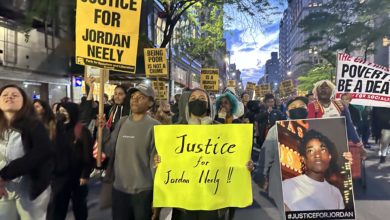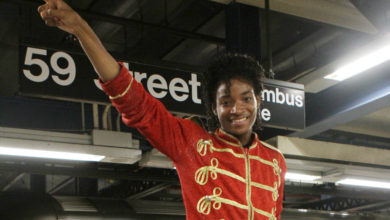The civil rights movement will
rightfully be the subject of much discussion this Black History
Month. However, one element of this history that tends to receive
very little attention was the interplay in the movement between
nonviolent tactics and self-defense.
While some civil rights leaders,
such as Dr. King and James Lawson, embraced and preached nonviolence
from a moral and philosophical perspective, this was not true for
many activists, who accepted it instead as a tactic. Recognizing
this, even Dr. King often stressed the strategic and practical
reasons for using nonviolence, rather than its philosophical merits.
Since the turn of the century, Black
activists like Ida B. Wells, Henry McNeal Turner and others had
advocated for armed responses to Jim Crow terrorism. In fact, in the
long history of the Black freedom struggle—in all its phases—the
concept of self-defense on an individual and community level had been
understood as a basic right.
This did not disappear during the
era of the civil rights Movement. In fact, on many occasions, Black
southerners continued to exercise self-defense to protect their
struggle in the face of white power terrorists. This happened not in
opposition to, but in conjunction with, nonviolent protest. It was
often armed defense, or at least the threat of force, that saved
civil rights workers from attacks from white supremacists.
Two particular sets of Freedom
Fighters should be noted in a discussion of the self-defense
tradition and civil rights: the grouping around the Monroe County,
N.C. chapter of the NAACP, led by Robert F Williams; and Louisiana’s
Deacons for Defense and Justice.
Robert F. Williams and the Monroe
County NAACP
Robert F. Williams had a rebellious
attitude toward white supremacy for his entire adult life. In the
1940s, Williams immigrated to Detroit from North Carolina to work in
the war industries. While in Detroit, he became part of movements for
racial and economic equality led by communists and other radicals.
After serving in the Korean War, Williams returned to Monroe County,
N.C., later becoming head of the local NAACP. He built a chapter
composed primarily of Black workers, including many veterans who were
exceptionally militant in their temperament and fed up with racism.
The Monroe NAACP chapter engaged in
a variety of struggles seeking desegregation in the later part of the
1950s. Unlike other trends in the movement, Williams’ group often
openly armed itself to ward off trouble.
Monroe County faced a truly vicious
Ku Klux Klan organization led by Catfish Cole. When the NAACP sought
to desegregate a swimming pool, Cole stated that any African American
going “to a white swimming pool is not looking for a bath … he is
looking for a funeral.” Amidst an escalation of Klan violence
throughout the state, Williams and his counterparts began to arm
themselves more systematically, developing military-like
organization, digging trenches and other strong-points in their
community, and setting up a rifle range.
In October 1957, after a very large
rally, the Klan decided to threaten Monroe’s Black community by
assembling a large armed motorcade. To their surprise, the
well-organized forces of Monroe’s NAACP let loose a hail of
gunfire, causing Klan members to flee at high speed in what quickly
became a rout. Clearly terrified of the implications of armed Blacks
ready to fight terrorism, the next day white city leaders banned KKK
motorcades. The Klansman—true cowards—never again returned for
night rides in Monroe County’s Black community.
Williams later gained national
attention defending a group of Monroe youths who were accused of
molesting a young white girl, and faced a local lynch mob. Such bold
stances drew criticism from more moderate civil rights forces,
including the NAACP national leadership, who did not want to take on
controversial cases and abhorred Williams’ ready acceptance of
assistance from communists and Black nationalists.
In the 1960s, Williams quickly
became a magnet for those around the country who supported the right
of Black people to arm themselves in the face of terror. His book
“Negroes With Guns” became something of a manifesto to young
militants convinced of the principle of self-defense. At the same
time, Williams did not eschew nonviolent tactics, engaging in sit-ins
in Monroe for example. Williams was later forced into exile—going
to Cuba and then China—after playing a key role in organizing
protection for nonviolent demonstrators in Monroe. At his 1996
funeral, Rosa Parks, who is now heralded as an icon of nonviolence,
told the audience that she had long admired Williams’ courage and
commitment.
The overlooked role of the
Deacons for Defense
Civil Rights demonstrations in
Bogalusa, La. had found relatively little success in the early 1960s.
By 1965, the seeming intractability of Jim Crow brought activists
from the Congress for Racial Equality to town. A victory in Bogalusa
would have been significant for the national movement since the local
Ku Klux Klan was notorious for its bold acts of terrorism and—as it
was across the South—was fully integrated into the local power
structure. A victory in Bogalousa would be a sign that the movement
could win anywhere.
Demonstrations in the city’s
downtown were first broken up by mobs, and in June, white
supremacists shot the first Black sheriff’s deputy while he was on
patrol.
Behind the scenes, a group of Black
men calling themselves the Deacons for Defense and Justice started
meeting, discussing tactics and slowly building an arsenal. The
Deacons’ style was understated, and they were essentially an
underground organization, with only a few leaders publically
proclaiming their membership. Nonetheless, they expanded quickly
throughout the South and even had a chapter in Illinois. In
particular, the Deacons sought to organize in areas where the Klan
was strongest. In cities like Bogalusa, they semi-secretly guarded
the offices and persons of civil rights activists.
In 1966, the Deacons drew national
attention over their participation in the multi-day March Against
Fear through Mississippi, during which the slogan “Black Power”
made its first appearance. The Deacons’ participation was
controversial because it did not fully conform to the image of
nonviolence. But they were ultimately allowed to remain; they hung
off to the side of the main march, securing the route against snipers
and ambushes. The Deacons also provided armed escorts to those
traveling to local airports at night.
While the full truth may never be
known, government authorities—and most likely the Klan—feared
that the Deacons may have been armed with grenades and automatic
weapons, which served as powerful deterrents to white supremacists
considering offensive action.
As quickly as they rose, however,
the Deacons faded into obscurity. As the legal phase of the civil
rights movement came to completion, the Deacons seemingly
disappeared. Some of its leaders continued their activism while many
of its members went back to their daily lives.
Defending home
Robert F. Williams and the Deacons
were not a bizarre exception to the movement. They reflected and were
a response to their local conditions. Deacon leaders frequently
praised “nonviolent” leaders, and their members often
participated unarmed in demonstrations. But, at the same time, in the
face of terrorism that had the ability to derail the protest movement
in small Klan strongholds, the Deacons and the Monroe County NAACP
used their weapons, and their organization, to level the playing
field.
Above all, it must be noted that
self-defense was a deeply rooted part of Black southern society, in
which having a gun, for both hunting and protection, was more the
norm than the exception. As a massive movement arose to demand equal
rights for Black Americans, many of those with arms rose to its
defense, either overtly or behind the scenes. Rather than a serious
tactical dispute between violence and nonviolence, the actions of
Williams, the Deacons and many like them played a crucial role in the
work of the Southern freedom movement.






